The Sherpa people are an indigenous Tibetan group that resides in Nepal’s most mountainous regions. Including the Tingri County in the Tibet Autonomous Region, and the Himalayas. Sherpas are known for their ability as climbers in the Himalayas. However, there is much more to the community than just being Mount Everest Sherpas.
Jamling Norgay, son of Tenzing Norgay had this to say:
“For a foreigner, a Sherpa means someone who carries loads at high altitudes. But Sherpas are actually all Tibetans. They are called ‘People from the East.’”
Jamling Norgay
This blog looks at the Sherpa community as a whole, as well as Sherpa’s incredible feats on Mt. Everest.
Who Are Sherpas:
The Sherpa people, also known as Sharwa, are a group of 112,946 people (2011 Nepali Census) who reside in mountainous regions across Nepal, the Indian state of Sikkim, and Tibet in China. They share ancestral ties with the Bhutia community.
Additionally, small Sherpa communities can be found in various parts of North America, Australia, and Europe. In 2017, New York had the largest Sherpa community in the US with around 3,000 Sherpas residing. The Sherpas have Tibetan roots and cultural heritage. They communicate using the Sherpa language, closely related to the form of Tibetan spoken in Tibet. While mainly a spoken language, Sherpa is occasionally transcribed using the Tibetan or Devanagari script. The majority of Sherpas in Nepal also speak Nepali, and those educated in Tibetan settings might also be fluent in the Tibetan language.
The term “Sherpa” originates from the Sherpa language words ཤར (“shar,” meaning “east”) and པ (“pa,” meaning “people”). Which denote their geographic origins in Khams, the eastern part of Tibet.
Their migration began in the 15th century, and for centuries, they engaged in trading (salt, wool, and rice), herding (yaks and cows), and farming (potatoes, barley, and buckwheat) for their livelihoods. The Sherpa culture is organized around a clan system (ru), wherein lineage is traced through the paternal line. All Sherpas are members of one of the 18 clans, each with its own clan name.
The term “Sherpa” has more recently come to encompass a variety of ethnic groups within the region known for their exceptional mountaineering and trekking abilities. Many of these individuals are indeed ethnic Sherpas. Their skills have been vital for successful ascents of various Himalayan mountains.
Sherpa Religion:
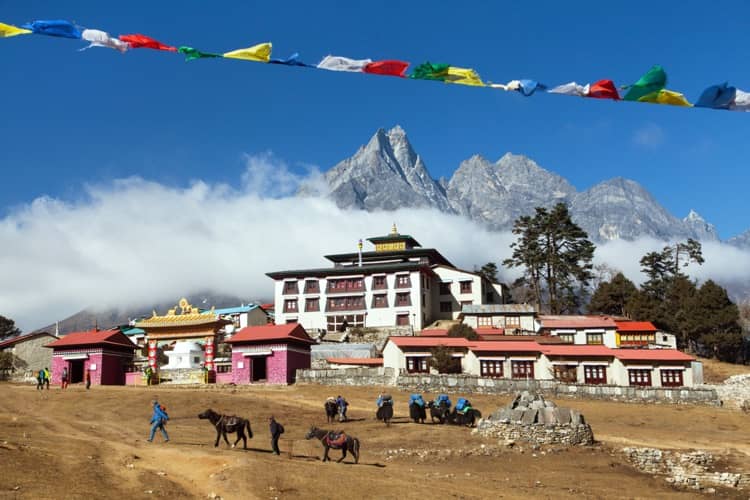
The Sherpas are followers of the Nyingmapa, or Red Hat, sect of Tibetan Buddhism, the oldest Buddhist sect in Tibet. This particular sect places a strong emphasis on mysticism and incorporates elements of shamanistic practices and local deities derived from the pre-Buddhist Bon religion. Alongside their reverence for Buddha and Buddhist deities, they also hold beliefs in a multitude of gods and demons. Who are thought to inhabit every mountain, cave, and forest on earth. These spiritual entities necessitate worship or appeasement through ancient rituals that have seamlessly integrated into the tapestry of Buddhist ceremonial life.
As many religions in Nepal do, numerous Himalayan peaks are venerated as divine beings. Among these, the Sherpas refer to Mount Everest as Chomolungma and revere it as the “Mother of the World.” Mount Makalu is regarded as the deity Shankar (Shiva).
Day-to-day religious matters within Sherpa communities are overseen by lamas, who are spiritual leaders of the Buddhist tradition, along with other religious practitioners residing within the villages. In addition, shamans (lhawa) and soothsayers (mindung) are involved in matters related to the supernatural and the spirit realm. They identify witches, act as intermediaries for gods and spirits, and diagnose illnesses.
A pivotal facet of Sherpa spirituality revolves around the monastery or gompa. Around two dozen of these establishments are situated throughout the Solu-Khumbu region with Tengboche being the initial celibate monastery in the region. These are communities of lamas or monks (occasionally nuns) who have taken vows of celibacy and lead lives of seclusion in pursuit of truth and spiritual enlightenment. They command respect from and are supported by the wider community.
History of Sherpas:
The Sherpa people were originally nomadic and first established their presence in the Solukhumbu District (Khumbu), Nepal. According to Sherpa oral traditions, four distinct groups embarked on migrations from Kham in Tibet to Solukhumbu during different periods, giving rise to the foundational Sherpa clans: Minyagpa, Thimmi, Sertawa, and Chawa. Over time, these four groups gradually evolved into the more than 20 diverse clans that exist today.
By the 15th century, the Khumbu Sherpa people had achieved a degree of autonomy within the newly formed Nepali state. However, during the 1960s, escalating tensions with China led to increased influence exerted by the Nepali government over the Sherpa community. The year 1976 marked the declaration of Khumbu as a national park, subsequently transforming tourism into a significant economic driver for Sherpas in the Everest region.
Where Are Sherpas From?
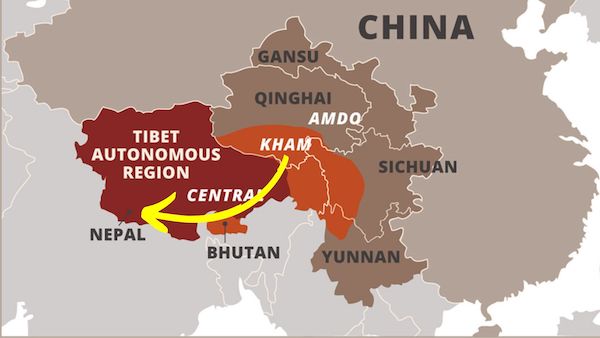
Sherpas trace their origins to the high-altitude regions of the Himalayas. Historically, Sherpas migrated from Kham in Tibet to the Solukhumbu district in Nepal, a transition that gradually took place over generations.
After migrating from Tibet, Sherpas are considered to be native to the Solu-Khumbu district, a region encompassing the Khumbu Valley and the Everest region. This district is located in the northeastern part of Nepal, near the border with Tibet (China).
The challenging, high-altitude environment of the Himalayas shaped the Sherpa way of life. Living at an average altitude of over 14,700 feet for thousands of years, they developed unique adaptations that allowed them to thrive in the thin air and harsh conditions.
The SoluKhumbu region, where Sherpas settled, includes iconic peaks like Mount Everest, which looms as the world’s tallest mountain. Through centuries of living amidst these breathtaking but formidable landscapes, Sherpas cultivated a deep knowledge of the terrain, weather patterns, and routes, forming the basis for their expertise as mountaineering guides.
Where Do Sherpas Live Now?
Sherpas reside in the eastern areas of Nepal, particularly in regions like Solu, Khumbu, and Pharak. However, there are also Sherpa communities located further west in places such as the Rolwaling valley and the Helambu region to the north of Kathmandu. Among their settlements, Pangboche stands as the oldest Sherpa village in Nepal, with a history of over 300 years.
The Sherpas primarily inhabit the Solu-Khumbu district around the Himalayas in Nepal. This region consists of two parts divided by the Sun Kosi River, a major tributary of the Kosi River.
- The Khumbu region, situated at elevations ranging from 12,000 to 14,000 feet (about 3,700 to 4,300 meters), includes even higher pasturelands. The Khumbu region stretches from the eastern Chinese (Tibetan) border to the banks of the Bhotekosi River in the west.
- The Solu region, on the other hand, lies at elevations of 8,000 to 10,000 feet (about 2,400 to 3,100 meters).
What do Sherpas do on Everest?
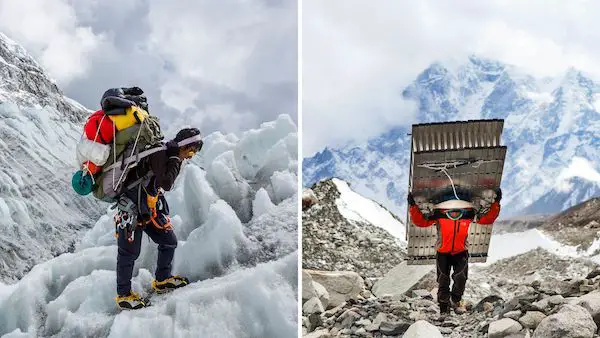
Sherpas on Everest play a vital role in supporting mountaineering expeditions. They serve as guides, porters, and essential members of the climbing team. Typically their responsibilities include:
1. Guides and Route Experts:
Sherpas are not only guides but also invaluable route experts. With their profound knowledge of Everest’s complex terrain, weather patterns, and safety protocols, they lead climbers with precision and care. Additionally, they meticulously prepare the climbing routes on Everest, securing ropes and ladders and establishing camps, ensuring that climbers can navigate challenging sections safely and confidently.
2. Logistics and Camp Management:
Sherpas take on the crucial responsibility of managing the logistical aspects of Everest expeditions. They shoulder the task of transporting heavy equipment through the Khumbu Icefall, setting up camps, and organizing supplies.
3. Risk Management and Medical Assistance:
As masters of risk assessment and management on the world’s highest peak, they are able to help climbers in their time of need. They have a keen understanding of the mountain’s hazards, including crevasses, avalanches, and unpredictable weather. Additionally, Sherpas possess basic medical training, allowing them to provide immediate assistance to climbers who may face altitude sickness or minor injuries.
A heroic example of this was in May 2023 when Gelje Sherpa rescued a Malaysian climber stranded in the Death Zone on Everest. Gelje was able to haul the climber 600 meters down from the Balcony to the South Col, over a period of about six hours. After that, a fellow sherpa, Nima Tashi Sherpa, joined in on the rescue.
4. Oxygen and Equipment Support:
At altitudes where oxygen is scarce, Sherpas play a pivotal role in managing oxygen systems. They handle the setup and maintenance of oxygen cylinders and ensure climbers have the necessary equipment to function in the higher altitudes of Everest.
5. Cultural Bridge and Support:
Sherpas extend beyond their technical roles to serve as a cultural bridge between international climbers and local communities. Their insights into local customs and practices create a cohesive and respectful environment, fostering mutual understanding. Sherpas also provide emotional support and encouragement, helping climbers maintain morale and camaraderie throughout the demanding journey.
In essence, Sherpas are the backbone of successful Everest expeditions, bringing their expertise, resilience, and dedication to the challenging environment of the world’s highest peak.
Why Are Sherpas Such Good Climbers?
Sherpas’ remarkable ability and performance at high altitudes, such as speed-climbing records, expert guiding, and conquering uncharted routes, prompts the question: what makes Sherpas such good climbers?
Recent research suggests that Sherpas possess a unique ability to optimize oxygen utilization. Living in the Himalayas for thousands of years, Sherpas have developed genetic traits enabling them to maximize oxygen efficiency.
In comparison to low-altitude individuals, who experience increased red blood cell production triggered by the hormone erythropoietin (EPO) during climbs, Sherpas elevate their red blood cell count more conservatively, minimizing the strain on the heart and reducing symptoms of altitude sickness.
A study by Andrew Murray of the University of Cambridge investigated Sherpas and lowlanders during an Everest Base Camp expedition. The results, published in Proceedings of the National Academy of Sciences, revealed Sherpas’ muscles exhibited greater efficiency in converting oxygen to energy. Their mitochondria, the energy-producing units, functioned more effectively, maximizing oxygen utilization and overall performance.
Additionally, Sherpas showcased anaerobic metabolism, producing energy without oxygen. These findings align with previous genetic research, which identified mutations linked to oxygen metabolism in Sherpas’ DNA.
The Genetics Of Sherpas:
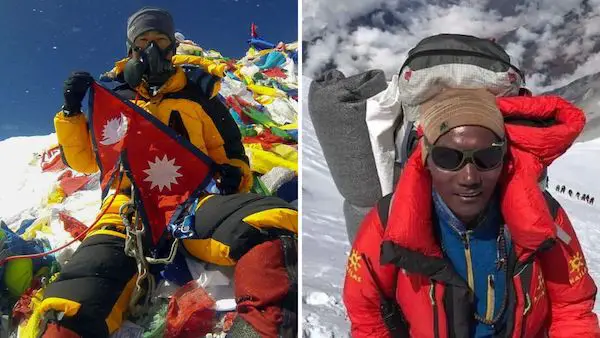
Genetic research indicates that a significant portion of the Sherpa population shares allele frequencies commonly found in other Tibeto-Burman regions. In the genes examined, the most pronounced similarity was observed with Tibetan population samples from the Xizang Tibetan Autonomous Region. Genetically, the Sherpa cluster exhibits its closest affinity with both the Tibetan and Han populations.
Furthermore, the Sherpa population displays a recognizable connection with various Nepalese populations. The strongest affinity is with the Rai people, followed by the Magars and the Tamang communities.
In a study conducted in 2010, over 30 genetic factors were identified that contribute to the adaptability of Tibetan bodies to high altitudes. Among these factors is EPAS1, often referred to as the “super-athlete gene,” which regulates hemoglobin production, enhancing the efficiency of oxygen utilization.
Do Sherpas Use Oxygen On Everest:
Despite Sherpas adapting to low oxygen environments more rapidly than other climbers, they still depend on supplementary oxygen. Even within the ‘death zone,’ where oxygen levels are critically low, Sherpas continue to face oxygen deficiencies, and the necessity of supplemental oxygen.
Sherpas stand among the elite in terms of physical fitness worldwide. Sherpa physiology seems to excel at these altitudes, operating at an elevated level, even as others exert themselves while scaling colossal summits, navigating through constrained oxygen levels and air pressure. This distinction arises because Sherpas are accustomed to functioning at elevated altitudes beyond the norm.
Certain Sherpa climbers have achieved ascents of lofty peaks without relying on supplemental oxygen. Ang Rita Sherpa, a notable Nepali mountaineer, accomplished the remarkable feat of summiting Mount Everest ten times between 1983 and 1996, all without the aid of supplementary oxygen.
Moreover, Babu Chhiri Sherpa achieved the extraordinary by spending 21 hours on the summit of Everest. Sheltered in a small tent. Using his radio, he chatted and sang Nepali folk songs, avoiding sleep upon doctors’ warnings as they warned him he might not wake up.
How Much Are Sherpas Paid?
Sherpas are typically paid between $2,000 and $5,000 for a season’s work, and there are additional bonuses if they successfully reach the summit which can range from $500-1,000.
In contrast, a Western guide’s earnings can reach around $50,000 per season, significantly higher than what Sherpas make in a season. While this is higher than Nepal’s average monthly salary, it’s essential to recognize that the profession carries substantial risks due to its inherent dangers. Whereas, in an Outside article discussing Sherpas, Grayson Schaffer stated:
“A Sherpa working above Base Camp on Everest is nearly ten times more likely to die than a commercial fisherman—the profession the Centers for Disease Control and Prevention rates as the most dangerous nonmilitary job in the U.S.”
Grayson Scheffer on Mount Everest Sherpas
Moreover, as a measure of workplace safety, a mortality rate of 1.2 percent is nothing to joke about. No other service sector globally exhibits such a high frequency of fatalities and injuries among its workforce in exchange for the satisfaction of paying clients.
Famous Mount Everest Sherpas:

Mount Everest Sherpas have become the backbone of high altitude climbing and have helped climbers from around the world reach the summit. With incredible accomplishments in mountaineering and on the slopes of Everest, here is a dhort list of some of the most famous Sherpas on Mt. Everest.
- Tenzing Norgay: Renowned for being one of the first climbers to reach the summit of Mount Everest along with Sir Edmund Hillary in 1953.
- Pasang Lhamu Sherpa: The first Nepali woman to successfully climb Mount Everest in 1993.
- Ang Rita Sherpa: Known as the “Snow Leopard” for his ten successful ascents of Mount Everest without supplemental oxygen between 1983 and 1996.
- Kami Rita Sherpa: Holds the record for the most ascents of Mount Everest, having reached the summit 28 times.
- Lhakpa Gelu Sherpa: Set a world record for the fastest ascent of Mount Everest in 2003, completing the climb in just under 11 hours.
- Lhakpa Tenzing Sherpa: Grandson of Tenzing Norgay, he has followed in his grandfather’s footsteps, becoming a skilled mountaineer and guide.
- Babu Chiri Sherpa: Famous for spending 21 hours on top of Everest without supplemental oxygen or sleeping.
Important Events in Sherpa History:
Below are some of the most important events regarding Mount Everest Sherpas.
First Sherpa to Climb Everest:
Tenzing Norgay, a Nepalese Sherpa, made history as the first Sherpa to conquer Mount Everest’s summit on May 29, 1953, alongside Sir Edmund Hillary. Their remarkable feat during the 1953 British Mount Everest expedition marked a momentous achievement in mountaineering history as they were finally able to conquer the tallest mountain in the world!
The 2013 Fight on Everest:
A group of climbers encountered unexpected conflict while ascending Mount Everest, facing Sherpa guides in a high-altitude altercation. Nepalese authorities are investigating the reported fight that took place at nearly 23,000 feet on the world’s tallest peak. The dispute began when three professional climbers from Italy, the UK, and Switzerland expressed their intention to climb independently. The three climbers were Swiss climber Ueli Steck, British climber Jonathan Griffith and Italian mountaineer Simone Moro.
Here are the contradicting stories from both sides:
Sherpa’s Story:
During a meeting at Camp II, a unanimous decision was reached not to proceed with climbing until the ropes were set by the Sherpas. At approximately 22,000 feet on April 27 around 8 a.m. the Sherpas observed the ascent of three foreign climbers. By radio they tried to tell others to stop them due to the risk of falling ice from higher up.
Regrettably, they ignored the warnings and proceeded upwards. Despite their efforts to stop them, they persisted, utilizing the ropes we had fixed. These climbers were later identified as Simone Moro, Ueli Steck, and Jonathan Griffith.
After the trio assured the team they would not interfere with the ropes, the Sherpas allowed them to proceed. As they continued their ascent to 23,000 feet, aiming to complete rope fixing to Camp III, the three climbers caused ice to fall striking the team lead in the face.
Simone Moro and Team’s Statement
The Sherpas allegedly became aggressive after claiming that ice was knocked onto a Sherpa below them. The situation escalated into physical violence, with allegations of punches, kicks, and thrown rocks from both sides.
Italian climber Simone Moro’s statement detailed the ordeal, recounting that around 100 Sherpas attacked the climbers. After nearly an hour of tension, the climbers regrouped and were warned by the Sherpas to leave within an hour under threat of being killed. The climbers decided to descend to the base of Mount Everest without ropes due to the dangerous circumstances.
The climbers were instructed not to ascend while Sherpas were setting ropes, but they proceeded despite the warning. Subsequently, a meeting took place between both parties, resulting in reconciliation and agreement to continue the climb. The climbers’ statement indicated that no evidence of Sherpa injuries was presented.
Deaths in 2014 Everest Avalanche (2014 Sherpa Strike):
On April 18, 2014, a massive serac collapsed above the Khumbu Icefall on Mount Everest, triggering a devastating avalanche of ice and snow that claimed the lives of 16 Nepalese guides, primarily Sherpas.
This 2014 avalanche stands as the second-deadliest years in the history of Mount Everest expeditions. Surpassed only by avalanches in the Khumbu Icefall area a year later. Which took place on April 25, 2015, triggered by a magnitude 7.8 earthquake in Nepal.
In response to these tragic incidents, and the absence of governmental support for Sherpas harmed or killed while rendering their services, Sherpa climbing guides ceased their work. Additionally, climbing companies decided to discontinue their expeditions that year in regard to the incident.
Following the 2014 disaster, the remaining Sherpas initiated a strike, fueled by frustration towards the government’s response, inadequate compensation, and their working conditions. In the aftermath of the tragedy, Sherpas united to formulate demands for the government, as depicted in the documentary “Sherpa.” International clients harbored apprehensions about the strike’s repercussions and kept their bags ready for a swift departure.
In total, 118 Sherpas have lost their lives on Mount Everest between 1921 and 2018. A report by NPR in April 2018 noted that Sherpas accounted for one-third of Everest’s fatalities.
2015 Nepali Earthquake on Everest:
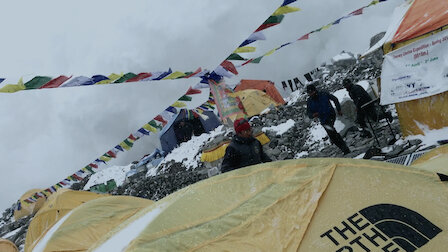
On the afternoon of April 25, 2015, a magnitude 7.8 earthquake struck Nepal. The seismic activity triggered a devastating avalanche from Pumori that descended onto the Base Camp of Mount Everest. The impact of the avalanche resulted in a tragic loss of life, claiming the lives of at least twenty-two individuals. This disaster exceeded the previous year’s avalanche in terms of fatalities, marking it as the deadliest event on the mountain.
According to an official report from the Nepal Mountaineering Association on April 28, the recorded deaths totaled 19. Including 10 identified Nepalese Sherpas and five foreign climbers. Four individuals remained unidentified. Among the foreign climbers, the casualties consisted of two Americans, one Chinese, one Australian, and one Japanese. However, by April 27, National Geographic reported a higher toll of 24 fatalities.
You can watch Netflix’s documentary Aftershock: Everest and the Nepal Earthquake, to learn more about the 2015 earthquake.
Mount Everest Sherpas – The Backbone of Everest
On Mount Everest, Sherpas have emerged as indispensable figures, embodying a unique blend of heritage, resilience, and expertise. Their remarkable capabilities in acclimatization, oxygen utilization, and mountaineering skills have made them essential partners for climbers aspiring to conquer the world’s highest peak.
From their pivotal role in guiding expeditions and ensuring safety to their enduring ties with the mountain’s history and culture. Sherpas have etched their legacy on Everest’s slopes. The triumphs of Sherpa climbers and guides, who have defied odds and shattered records, shows just how remarkable they are.
As Everest continues to captivate adventurers worldwide, the capabilities of Sherpas remain an essential component in conquering Everest!
